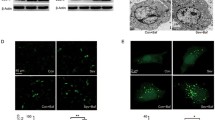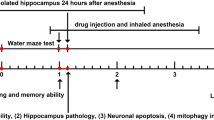Abstract
An increasing number of studies have found that use of traditional anesthetics may lead to cognitive impairment of the immature brain. Our previous studies verified that cyclin-dependent kinase 5 (CDK5) plays a role in sevoflurane-induced cognitive dysfunction. Autophagy was shown to protect against anesthesia-induced nerve injury. Therefore, the current study aimed to ascertain if autophagy participates in anesthesia-induced neurotoxicity. In this study, primary hippocampal neurons were isolated and utilized for experiments in vitro. We also performed in vivo experiments with 6-day-old wild-type mice treated with or without roscovitine (Rosc, a CDK5 inhibitor) or 3-methyladenine (3-Ma, an autophagy inhibitor) after exposure to sevoflurane. We used the Morris water maze to analyze cognitive function. Immunohistochemical staining was used to assess pathologic changes in the hippocampus. The results showed that suppressing CDK5 reversed sevoflurane-induced nerve cell apoptosis both in vivo and in vitro and demonstrated that inhibits CDK5 activation promoted Sirtuin 1 (Sirt1) expression, which functions importantly in induced autophagy activation. Suppression of Sirt1 expression inhibited the protective effect of Rosc on sevoflurane-induced nerve injury by inhibiting autophagy activation. Our in vivo experiments also found that pretreatment with 3-Ma attenuated the protective effect of Rosc on sevoflurane-induced nerve injury and cognitive dysfunction. We conclude that inhibits CDK5 activation restored sevoflurane-induced cognitive dysfunction by promoting Sirt1-mediated autophagy.






Similar content being viewed by others
References
Alkire MT, Gruver R, Miller J, McReynolds JR, Hahn EL, Cahill L (2008) Neuroimaging analysis of an anesthetic gas that blocks human emotional memory. Proc Natl Acad Sci USA 105(5):1722–1727. https://doi.org/10.1073/pnas.07116511050711651105
Chang HC, Guarente L (2013) SIRT1 mediates central circadian control in the SCN by a mechanism that decays with aging. Cell 153(7):1448–1460. https://doi.org/10.1016/j.cell.2013.05.027S0092-8674(13)00594-1
Fan L, Chen D, Wang J, Wu Y, Li D, Yu X (2017) Sevoflurane ameliorates myocardial cell injury by inducing autophagy via the deacetylation of LC3 by SIRT1. Anal Cell Pathol (Amst) 2017:6281285. https://doi.org/10.1155/2017/6281285
Ge HW, Hu WW, Ma LL, Kong FJ (2015) Endoplasmic reticulum stress pathway mediates isoflurane-induced neuroapoptosis and cognitive impairments in aged rats. Physiol Behav 151:16–23. https://doi.org/10.1016/j.physbeh.2015.07.008S0031-9384(15)30023-8
Ghatge S, Lee J, Smith I (2003) Sevoflurane: an ideal agent for adult day-case anesthesia? Acta Anaesthesiol Scand 47(8):917–931
Glick D, Barth S, Macleod KF (2010) Autophagy: cellular and molecular mechanisms. J Pathol 221(1):3–12. https://doi.org/10.1002/path.2697
Guo X, Lv J, Lu J, Fan L, Huang X, Hu L, Wang J, Shen X (2018) Protopanaxadiol derivative DDPU improves behavior and cognitive deficit in AD mice involving regulation of both ER stress and autophagy. Neuropharmacology 130:77–91. https://doi.org/10.1016/j.neuropharm.2017.11.033
Gutierrez-Vargas JA, Munera A, Cardona-Gomez GP (2015) CDK5 knockdown prevents hippocampal degeneration and cognitive dysfunction produced by cerebral ischemia. J Cereb Blood Flow Metab 35(12):1937–1949. https://doi.org/10.1038/jcbfm.2015.150jcbfm2015150
Hong T, Ge Z, Meng R, Wang H, Zhang P, Tang S, Lu J, Gu T, Zhu D, Bi Y (2018) Erythropoietin alleviates hepatic steatosis by activating SIRT1-mediated autophagy. Biochim Biophys Acta 1863 6:595–603
Komita M, Jin H, Aoe T (2013) The effect of endoplasmic reticulum stress on neurotoxicity caused by inhaled anesthetics. Anesth Analg 117(5):1197–1204. https://doi.org/10.1213/ANE.0b013e3182a74773
Kroemer G, Marino G, Levine B (2010) Autophagy and the integrated stress response. Mol Cell 40(2):280–293. https://doi.org/10.1016/j.molcel.2010.09.023S1097-2765(10)00751-3
Li X, Wu Z, Zhang Y, Xu Y, Han G, Zhao P (2017) Activation of autophagy contributes to sevoflurane-induced neurotoxicity in fetal rats. Front Mol Neurosci 10:432. https://doi.org/10.3389/fnmol.2017.00432
Lin D, Zuo Z (2011) Isoflurane induces hippocampal cell injury and cognitive impairments in adult rats. Neuropharmacology 61(8):1354–1359. https://doi.org/10.1016/j.neuropharm.2011.08.011S0028-3908(11)00344-3
Liu B, Xia J, Chen Y, Zhang J (2017a) Sevoflurane-induced endoplasmic reticulum stress contributes to neuroapoptosis and BACE-1 expression in the developing brain: the role of eIF2alpha. Neurotox Res 31(2):218–229. https://doi.org/10.1007/s12640-016-9671-z10.1007/s12640-016-9671-z
Liu J, Yang J, Xu Y, Guo G, Cai L, Wu H, Zhao Y, Zhang X (2017b) Roscovitine, a CDK5 inhibitor, alleviates sevoflurane-induced cognitive dysfunction via regulation tau/GSK3beta and ERK/PPARgamma/CREB signaling. Cell Physiol Biochem 44(2):423–435. https://doi.org/10.1159/000485008000485008
Lv X, Yan J, Jiang J, Zhou X, Lu Y, Jiang H (2017) MicroRNA-27a-3p suppression of peroxisome proliferator-activated receptor-gamma contributes to cognitive impairments resulting from sevoflurane treatment. J Neurochem 143(3):306–319. https://doi.org/10.1111/jnc.14208
Michan S, Sinclair D (2007) Sirtuins in mammals: insights into their biological function. Biochem J 404(1):1–13. https://doi.org/10.1042/BJ20070140
Ou X, Lee MR, Huang X, Messina-Graham S, Broxmeyer HE (2014) SIRT1 positively regulates autophagy and mitochondria function in embryonic stem cells under oxidative stress. Stem Cells 32(5):1183–1194. https://doi.org/10.1002/stem.1641
Qiu R, Li W, Liu Y (2018) MicroRNA-204 protects H9C2 cells against hypoxia/reoxygenation-induced injury through regulating SIRT1-mediated autophagy. Biomed Pharmacother 100:15–19. https://doi.org/10.1016/j.biopha.2018.01.165
Rohan D, Buggy DJ, Crowley S, Ling FK, Gallagher H, Regan C, Moriarty DC (2005) Increased incidence of postoperative cognitive dysfunction 24 hr after minor surgery in the elderly. Can J Anaesth 52(2):137–142. https://doi.org/10.1007/BF03027718
Shen X, Dong Y, Xu Z, Wang H, Miao C, Soriano SG, Sun D, Baxter MG, Zhang Y, Xie Z (2013) Selective anesthesia-induced neuroinflammation in developing mouse brain and cognitive impairment. Anesthesiology 118(3):502–515. https://doi.org/10.1097/ALN.0b013e3182834d77
Stunkel W, Campbell RM (2011) Sirtuin 1 (SIRT1): the misunderstood HDAC. J Biomol Screen 16(10):1153–1169. https://doi.org/10.1177/10870571114221031087057111422103
Sun T, Jiao L, Wang Y, Yu Y, Ming L (2018) SIRT1 induces epithelial-mesenchymal transition by promoting autophagic degradation of E-cadherin in melanoma cells. Cell Death Dis 9(2):136. https://doi.org/10.1038/s41419-017-0167-410.1038/s41419-017-0167-4
Wang Y, Wang W, Li D, Li M, Wang P, Wen J, Liang M, Su B, Yin Y (2014) IGF-1 alleviates NMDA-induced excitotoxicity in cultured hippocampal neurons against autophagy via the NR2B/PI3K-AKT-mTOR pathway. J Cell Physiol 229(11):1618–1629. https://doi.org/10.1002/jcp.24607
Wiklund A, Granon S, Faure P, Sundman E, Changeux JP, Eriksson LI (2009) Object memory in young and aged mice after sevoflurane anaesthesia. NeuroReport 20(16):1419–1423. https://doi.org/10.1097/WNR.0b013e328330cd2b
Xiao X, Zhu Y, Bu J, Li G, Liang Z, Yang L, Hou B (2017) The autophagy inhibitor 3-methyladenine restores sevoflurane anesthesiainduced cognitive dysfunction and neurons apoptosis. Pharmazie 72(4):214–218. https://doi.org/10.1691/ph.2017.6872
Yang L, Gu X, Zhang W, Zhang J, Ma Z (2014) Cdk5 inhibitor roscovitine alleviates neuropathic pain in the dorsal root ganglia by downregulating N-methyl-D-aspartate receptor subunit 2A. Neurol Sci 35(9):1365–1371. https://doi.org/10.1007/s10072-014-1713-9
Zhang Q, Zhang P, Qi GJ, Zhang Z, He F, Lv ZX, Peng X, Cai HW, Li TX, Wang XM, Tian B (2018a) Cdk5 suppression blocks SIRT1 degradation via the ubiquitin-proteasome pathway in Parkinson's disease models. Biochim Biophys Acta 1862 6:1443–1451. https://doi.org/10.1016/j.bbagen.2018.03.021
Zhang YP, Lou Y, Hu J, Miao R, Ma F (2018b) DHA supplementation improves cognitive function via enhancing Abeta-mediated autophagy in Chinese elderly with mild cognitive impairment: a randomised placebo-controlled trial. J Neurol Neurosurg Psychiatry 89(4):382–388. https://doi.org/10.1136/jnnp-2017-316176jnnp-2017-316176
Zhang Z, Zhang P, Qi GJ, Jiao FJ, Wang QZ, Yan JG, He F, Zhang Q, Lv ZX, Peng X, Cai HW, Chen X, Sun N, Tian B (2018c) CDK5-mediated phosphorylation of Sirt2 contributes to depressive-like behavior induced by social defeat stress. Biochim Biophys Acta 1864 2:533–541. https://doi.org/10.1016/j.bbadis.2017.11.012
Zheng YL, Zhang X, Fu HX, Guo M, Shukla V, Amin ND, Jing E, Ba L, Luo HY, Li B, Lu XH, Gao YC (2016) Knockdown of expression of Cdk5 or p35 (a Cdk5 activator) results in podocyte apoptosis. PLoS ONE 11(8):e0160252. https://doi.org/10.1371/journal.pone.0160252PONE-D-15-43733
Zhou YF, Wang QX, Zhou HY, Chen G (2016) Autophagy activation prevents sevoflurane-induced neurotoxicity in H4 human neuroglioma cells. Acta Pharmacol Sin 37(5):580–588. https://doi.org/10.1038/aps.2016.6aps20166
Acknowledgements
This study was supported Tongji Medical School, Shanghai Tongji Hospital, Tongji University.
Funding
This study was supported by the National Natural Science Foundation (No. 81600934 to Jianhui Liu), National Natural Science Foundation of China (81974155 to Jianhui Liu), Pujiang Talent Programme (2019PJD049 to Jianhui Liu), the Natural Science Foundation of Shanghai, China (No. 16ZR1432200 to Jianhui Liu), and Medicine guidance of Science and Technology Commission of Shanghai Municipality (No. 16411967700 to Jianhui Liu).
Author information
Authors and Affiliations
Contributions
XZ and JL designed and conceived the study. XY, WZ, HW, SF, and JY performed the analysis and experiments. SL and YZ drafted the manuscript.
Corresponding author
Ethics declarations
Conflict of interest
All authors declare that they have no competing interest.
Ethical Approval
All applicable international, national, and/or institutional guidelines for the care and use of animals were approved by the Shanghai Tongji Hospital, Tongji Medical School, Tongji University. The experiments of this manuscript comply with the current laws of the country in which they were performed.
Additional information
Publisher's Note
Springer Nature remains neutral with regard to jurisdictional claims in published maps and institutional affiliations.
Rights and permissions
About this article
Cite this article
Yang, X., Zhang, W., Wu, H. et al. Downregulation of CDK5 Restores Sevoflurane-Induced Cognitive Dysfunction by Promoting SIRT1-Mediated Autophagy. Cell Mol Neurobiol 40, 955–965 (2020). https://doi.org/10.1007/s10571-020-00786-6
Received:
Accepted:
Published:
Issue Date:
DOI: https://doi.org/10.1007/s10571-020-00786-6




